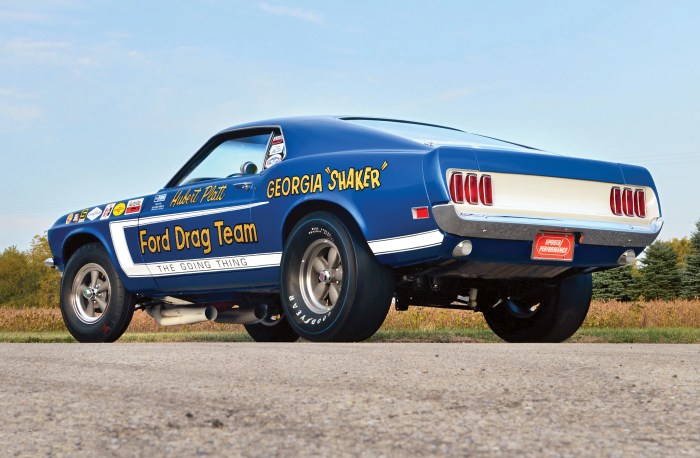How to make a drag car – Welcome to the world of drag racing, where speed, precision, and adrenaline converge. In this comprehensive guide, we’ll delve into the intricacies of building a drag car, from the essential components to performance modifications and safety considerations. Get ready to unleash your inner racer and create a machine that will dominate the track.
From understanding the purpose of a drag car’s engine to mastering the art of reading the track, this guide will equip you with the knowledge and techniques to build a drag car that meets your specific needs and aspirations.
Drag Car Components
Drag cars are highly specialized vehicles designed for maximum acceleration and top speed over short distances. Their components are meticulously engineered to work in harmony, creating a machine capable of mind-boggling performance.
Engine
The heart of a drag car is its engine, typically a modified version of a production engine. Drag car engines are built to withstand extreme stress and produce enormous power. They feature high-performance components such as forged pistons, strengthened crankshafts, and modified camshafts to optimize airflow and combustion.
Transmission and Drivetrain

The transmission and drivetrain play a crucial role in transferring power from the engine to the wheels. Drag cars typically use specialized transmissions designed for quick and precise gear changes. The drivetrain, including the driveshaft and rear axle, is also reinforced to handle the immense torque produced by the engine.
Suspension and Chassis Design
Drag car suspension and chassis design are critical for maintaining traction and stability during high-speed runs. Drag cars often employ sophisticated suspension systems that allow for precise adjustments to optimize weight distribution and minimize wheel hop. The chassis is constructed using lightweight materials and designed to provide rigidity and strength.
Safety Considerations
Drag racing is an inherently dangerous sport, and safety is paramount. Strict regulations and requirements are in place to protect drivers and spectators.
Safety Regulations and Requirements
Drag racing organizations have established comprehensive safety regulations governing everything from vehicle construction to driver qualifications. These regulations include requirements for roll cages, fire suppression systems, and safety gear for drivers.
Safety Gear and Equipment
Drag racers wear specialized safety gear designed to protect them in the event of an accident. This gear includes helmets, fire-resistant suits, and HANS (Head and Neck Support) devices.
Track Safety Officials
Track safety officials play a vital role in ensuring the safety of drag races. They are responsible for inspecting vehicles, monitoring the track, and responding to emergencies.
Drag Racing Techniques
Drag racing requires a combination of skill, technique, and knowledge. Experienced drivers employ specific techniques to optimize their performance.
Launching Off the Line
A successful drag race begins with a powerful launch off the starting line. Drivers use techniques such as “staging” their cars and “power braking” to build up torque and minimize wheel spin.
Shifting Gears and Maintaining Traction
Drag racers shift gears quickly and precisely to maintain maximum acceleration. They also use techniques like “traction control” and “weight transfer” to prevent wheel spin and keep the car planted on the track.
Reading the Track and Anticipating Conditions
Experienced drag racers are skilled at reading the track and anticipating changing conditions. They can adjust their driving techniques accordingly to optimize performance.
Performance Modifications

Drag cars often undergo extensive performance modifications to increase speed and acceleration. These modifications can range from simple bolt-on upgrades to complex engine tuning and aerodynamic enhancements.
Engine Tuning
Engine tuning involves optimizing various engine parameters, such as fuel injection, ignition timing, and boost pressure, to increase power output. Drag racers often use engine management systems to fine-tune their engines for maximum performance.
Nitrous Oxide Systems
Nitrous oxide systems inject a mixture of nitrous oxide and fuel into the engine, providing a temporary boost in power. Drag racers use nitrous oxide to gain an edge during critical moments of a race.
Aerodynamic Enhancements
Drag cars often incorporate aerodynamic enhancements, such as spoilers, wings, and diffusers, to reduce drag and improve stability at high speeds.
Drag Racing Culture
Drag racing has a rich history and culture, attracting enthusiasts from all walks of life. It is a sport that celebrates speed, adrenaline, and the pursuit of performance.
History and Evolution

Drag racing has its roots in illegal street racing in the early 20th century. Over time, it evolved into a organized sport with sanctioned events and dedicated drag strips.
Famous Drag Racers and Legendary Races, How to make a drag car
Drag racing has produced legendary drivers and iconic races that have captured the imagination of fans worldwide. Names like Don Garlits, Shirley Muldowney, and John Force have become synonymous with the sport.
Social and Cultural Significance
Drag racing has a significant social and cultural impact. It has inspired movies, television shows, and music, and has become a popular form of entertainment for millions of people.
Answers to Common Questions: How To Make A Drag Car
What is the most important component of a drag car?
The engine is the heart of a drag car, providing the power and torque necessary for acceleration and speed.
How can I improve the performance of my drag car?
Common performance modifications include engine tuning, nitrous oxide systems, and aerodynamic enhancements.
What safety precautions should I take when drag racing?
Safety regulations and requirements include wearing proper safety gear, adhering to track safety protocols, and having a qualified crew present.
